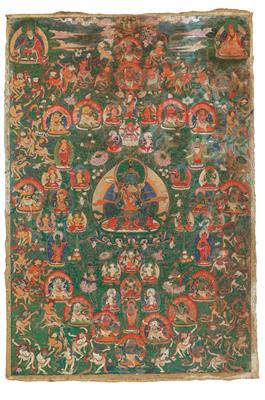A Thangka - “The Deities of the Tibetan Book of the Dead”, Tibet, 18th Century

Nyingma tradition, pigment and water-soluble binding agent on fabric, 92 x 62 cm, creased, torn, (Hr) We are grateful to Dipl. Ing. Uwe Niebuhr, BA MA for his assistance in cataloguing this work.
The present thangka depicts Ādibuddha Samantabhadra (Tibetan kun tu bzang po) with his partner Samantabhadrī (Tibetan kun tu bzang mo) and the deities of Guhyagarbha Tantra (Tibetan rgyud gsang ba'i snying po) of the Nyingma tradition of Tibetan Buddhism. The latter are also known as the 42 peaceful and 58 wrathful deities of the Tibetan Book of the Dead, a work attributed to the 8th-century Guru Padmasambhava. He is said to have concealed the text in a mountain in the Dagpo region of southwestern Tibet. According to legend, this tantra was found in the 14th century by a scholar named Karmalingpa (Tibetan karma gling pa) as a spiritual treasure text (Tibetan gter ma), and written down. The text describes the visionary experiences from the moment of death until rebirth. The path of this intermediate state (Tibetan bar do) determines whether the deceased person attains a new rebirth in one of the six realms of the Wheel of Life (Sanskrit bhavacakra) or is liberated from the eternal cycle. Practicing Buddhists learn the meditative path through the various stations of the intermediate state already during their lifetime, and the present thangka serves as an aid in visualising the numerous deities. At the time of death, the text is read out loud to the deceased person so that he or she remembers the path to salvation. For this reason, the Tibetan Book of the Dead also became known as Bardo Thödol (Tibetan bar do thos grol), which translates as “Liberation Through Hearing During the Intermediate State”. These writings are read on a daily basis for a period of at least 14 days, sometimes up to 49 days, with the first two weeks being dedicated to the peaceful and wrathful deities. The upper section of the present thangka depicts the white Ādibuddha Vajrasattva [A], resting on clouds. In the upper left corner is Guru Padmasambhava [B], and just opposite is the important Nyingma scholar Longchen Rabjam (1308-1364, Tibetan klong chen rab 'byams) [C]. Below them is the circle of peaceful and wrathful deities. The 42 peaceful deities [marked with white numbers in the illustration] appear in the first seven days. In the center of the picture is the blue Ādibuddha Samantabhadra and his white partner [1-2]. This Buddha is regarded as the purest and highest light ever attainable. The deities of the Book of the Dead hold a kind of mirror before the deceased person, so that he or she can recognise this light. Tathāgata Vairocana and his partner [3-4] appear on the first day. On the second to the fifth day, more Tathāgatas come to the fore: Akṣobhya [5-10], Ratnasambhava [11-16], Amitābha [17-22], Amoghasiddhi [23-28] - each with their entourage of partners, two Mahābodhisattvas and two Ḍākinīs. On the sixth day, all of the aforementioned deities reappear together, with the six Buddhas of the Wheel of Life [29-34] and the four gate-keepers with their respective partners [35-42]. The seven-day cycle terminates with the group of “wisdom-holders” (Sanskrit vidyādhara), depicted as five pairs of gods [43-52]. The second cycle, also lasting seven days, is marked by the appearance of the 58 wrathful deities [indicated in yellow numbers in the illustration]. They also endeavour to lead the deceased person to the right path. From the eighth to the twelfth day, there is one winged Heruka with their respective partner for each day: Buddha-Heruka [1-2], Vajra-Heruka [3-4], Ratna-Heruka [5-6], Padma-Heruka [7-8] and Karma-Heruka [9-10]. On the thirteenth day, three groups appear at once: the “8 female Gaurī Mamo” [11-18], the “8 animal-headed Tamenma” [19-26] and the “4 gate-keepers” [27-30]. On the fourteenth day, the group of “28 animal-headed goddesses” [31-54] and another “4 goalkeepers” complete the cycle. This group of 58 wrathful deities is joined by another couple that specifically embody the wrathful nature of Samamtabhadra: Chemchok-Heruka and his partner [59-60]. The religious background of this thangka is complex, and a detailed explanation would require many pages. This item must be regarded as rare, since only few thangkas depict all the deities of the Tibetan Book of the Dead as the present one does. The extremely beautiful composition of the deities and their magnificent colours also underline the special character of this thangka.
Expert: Regina Herbst
 Regina Herbst
Regina Herbst
+43-1-515 60-356
regina.herbst@dorotheum.at
21.09.2020 - 14:00
- Dosažená cena: **
-
EUR 6.400,-
- Vyvolávací cena:
-
EUR 2.000,-
A Thangka - “The Deities of the Tibetan Book of the Dead”, Tibet, 18th Century
Nyingma tradition, pigment and water-soluble binding agent on fabric, 92 x 62 cm, creased, torn, (Hr) We are grateful to Dipl. Ing. Uwe Niebuhr, BA MA for his assistance in cataloguing this work.
The present thangka depicts Ādibuddha Samantabhadra (Tibetan kun tu bzang po) with his partner Samantabhadrī (Tibetan kun tu bzang mo) and the deities of Guhyagarbha Tantra (Tibetan rgyud gsang ba'i snying po) of the Nyingma tradition of Tibetan Buddhism. The latter are also known as the 42 peaceful and 58 wrathful deities of the Tibetan Book of the Dead, a work attributed to the 8th-century Guru Padmasambhava. He is said to have concealed the text in a mountain in the Dagpo region of southwestern Tibet. According to legend, this tantra was found in the 14th century by a scholar named Karmalingpa (Tibetan karma gling pa) as a spiritual treasure text (Tibetan gter ma), and written down. The text describes the visionary experiences from the moment of death until rebirth. The path of this intermediate state (Tibetan bar do) determines whether the deceased person attains a new rebirth in one of the six realms of the Wheel of Life (Sanskrit bhavacakra) or is liberated from the eternal cycle. Practicing Buddhists learn the meditative path through the various stations of the intermediate state already during their lifetime, and the present thangka serves as an aid in visualising the numerous deities. At the time of death, the text is read out loud to the deceased person so that he or she remembers the path to salvation. For this reason, the Tibetan Book of the Dead also became known as Bardo Thödol (Tibetan bar do thos grol), which translates as “Liberation Through Hearing During the Intermediate State”. These writings are read on a daily basis for a period of at least 14 days, sometimes up to 49 days, with the first two weeks being dedicated to the peaceful and wrathful deities. The upper section of the present thangka depicts the white Ādibuddha Vajrasattva [A], resting on clouds. In the upper left corner is Guru Padmasambhava [B], and just opposite is the important Nyingma scholar Longchen Rabjam (1308-1364, Tibetan klong chen rab 'byams) [C]. Below them is the circle of peaceful and wrathful deities. The 42 peaceful deities [marked with white numbers in the illustration] appear in the first seven days. In the center of the picture is the blue Ādibuddha Samantabhadra and his white partner [1-2]. This Buddha is regarded as the purest and highest light ever attainable. The deities of the Book of the Dead hold a kind of mirror before the deceased person, so that he or she can recognise this light. Tathāgata Vairocana and his partner [3-4] appear on the first day. On the second to the fifth day, more Tathāgatas come to the fore: Akṣobhya [5-10], Ratnasambhava [11-16], Amitābha [17-22], Amoghasiddhi [23-28] - each with their entourage of partners, two Mahābodhisattvas and two Ḍākinīs. On the sixth day, all of the aforementioned deities reappear together, with the six Buddhas of the Wheel of Life [29-34] and the four gate-keepers with their respective partners [35-42]. The seven-day cycle terminates with the group of “wisdom-holders” (Sanskrit vidyādhara), depicted as five pairs of gods [43-52]. The second cycle, also lasting seven days, is marked by the appearance of the 58 wrathful deities [indicated in yellow numbers in the illustration]. They also endeavour to lead the deceased person to the right path. From the eighth to the twelfth day, there is one winged Heruka with their respective partner for each day: Buddha-Heruka [1-2], Vajra-Heruka [3-4], Ratna-Heruka [5-6], Padma-Heruka [7-8] and Karma-Heruka [9-10]. On the thirteenth day, three groups appear at once: the “8 female Gaurī Mamo” [11-18], the “8 animal-headed Tamenma” [19-26] and the “4 gate-keepers” [27-30]. On the fourteenth day, the group of “28 animal-headed goddesses” [31-54] and another “4 goalkeepers” complete the cycle. This group of 58 wrathful deities is joined by another couple that specifically embody the wrathful nature of Samamtabhadra: Chemchok-Heruka and his partner [59-60]. The religious background of this thangka is complex, and a detailed explanation would require many pages. This item must be regarded as rare, since only few thangkas depict all the deities of the Tibetan Book of the Dead as the present one does. The extremely beautiful composition of the deities and their magnificent colours also underline the special character of this thangka.
Expert: Regina Herbst
 Regina Herbst
Regina Herbst
+43-1-515 60-356
regina.herbst@dorotheum.at
|
Horká linka kupujících
Po-Pá: 9.00 - 18.00
kundendienst@dorotheum.at +43 1 515 60 200 |
| Aukce: | Starožitnosti |
| Typ aukce: | Sálová aukce s Live bidding |
| Datum: | 21.09.2020 - 14:00 |
| Místo konání aukce: | Wien | Palais Dorotheum |
| Prohlídka: | 16.09. - 21.09.2020 |
** Kupní cena vč. poplatku kupujícího a DPH
Není již možné podávat příkazy ke koupi přes internet. Aukce se právě připravuje resp. byla již uskutečněna.
